Cold Hardiness of Prunus mume ‘Xiang Ruibai’ and Its Parents Based on Biological Indexes and Physical Parameters
Abstract
:1. Introduction
2. Materials and Methods
2.1. Plant Materials and Treatments
2.2. Measurement of Ion Leakage
2.3. Determination of Freezing Tolerance
2.4. Paraffin Section
2.5. Infrared Video Thermography
2.6. Measurement of Stem Water Content in Field by Stem Moisture Sensor
2.7. SOD and POD Activity Determination
2.8. Gene Expression Analysis and Validation
2.9. Statistical Analysis
3. Results
3.1. Heat Release and Icing of Different Varieties of P. mume at Low Temperatures
3.2. Damage and Cold-Tolerance Ability of Different Varieties of P. mume
3.3. Antioxidant Enzymes SOD and POD Induce Cold Acclimation Ability of XR
4. Discussion
5. Conclusions
Supplementary Materials
Author Contributions
Funding
Acknowledgments
Conflicts of Interest
References
- Chen, J. Sixty years of Prunus mume research. J. Beijing For. Coll. 2002, Z1, 224–229. [Google Scholar]
- Chen, J. Prunus Mume Species Atlas in China. China Forestry Publishing House: Beijing, China, 2010; pp. 10–11. ISBN 978-7-5038-5539-9. [Google Scholar]
- Chen, J. Study on Prunus mume in China-experiment on introduction and domestication of Prunus mume. Acta Hortic. Sin. 1963, 2, 395–410. [Google Scholar]
- Chen, J.; Zhang, Q. Study on cold resistance breeding and regional test of Prunus mume. J. Beijing For. Coll. 1995, 17, 42–45. [Google Scholar]
- Chen, J.; Chen, R. On the classification system of Prunus mume cultivars. Acta Hortic. 2007, 34, 1055–1058. [Google Scholar] [CrossRef]
- Zhang, Q. Comparative analysis of cold resistance of Prunus mume. J. Beijing For. Coll. 1985, 02, 47–56. [Google Scholar]
- Li, Q. Preliminary report on regional test of cold-resistant Prunus mume varieties in Urumqi. J. Beijing For. Coll. 2012, S1, 50–55. [Google Scholar]
- Duan, M.; Li, W.; Gao, X.; Sun, Y.; Li, Q. Study on cold resistance of three Prunus mume varieties. Res. Prog. Ornam. Hortic. China 2015, S685.17, 504–508. [Google Scholar]
- Jiang, L.; Chen, J. A brief introduction to “transferring Prunus mume from south to north”–performance and prospect. China Landsc. Archit. 2011, 27, 1. [Google Scholar]
- Chen, R.; Zhang, Q.; Chen, J. A new aromatic cold-resistant Prunus mume variety-’Xiangruibai’. In Proceedings of the National Symposium on Flower Research and Production Technology Development Facing the New Century, Nanjing, China, 24–26 August 2005; S334, pp. 30–34. [Google Scholar]
- Hughes, M.A.; Pearce, R.S. Low temperature treatment of barley plants causes altered gene expression in shoot meristems. J. Exp. Bot. 1988, 39, 1461–1467. [Google Scholar] [CrossRef]
- Mccully, M.E.; Canny, M.J.; Huang, C.X. The management of extracellular ice by petioles of frost-resistant herbaceous plants. Ann. Bot. 2004, 94, 665–674. [Google Scholar] [CrossRef] [Green Version]
- Pearce, R.S. Extracellular ice and cell shape in frost-stressed cereal leaves: A low-temperature scanning-electron-microscopy study. Planta 1988, 175, 313–324. [Google Scholar] [CrossRef]
- Kodama, H.; Horiguchi, G.; Nishiuchi, T.; Nishimura, M.; Iba, K. Fatty acid desaturation during chilling acclimation is one of the factors involved in conferring low-temperature tolerance to young Tobacco leaves. Plant Physiol. 1995, 107, 1177–1185. [Google Scholar] [CrossRef] [Green Version]
- Chinnusamy, V.; Zhu, J.; Zhou, T.; Zhu, J.K. Small Rnas: Big role in abiotic stress tolerance of plants. In Advances in Molecular Breeding Toward Drought and Salt Tolerant Crops; Springer: Dordrecht, The Netherland, 2007. [Google Scholar]
- Shi, Y.; Ding, Y.; Yang, S. Cold signal transduction and its interplay with phytohormones during cold acclimation. Plant Cell Physiol. 2015, 56, 7–15. [Google Scholar] [CrossRef]
- Thomashow, M.F.; Stockinger, E.J.; Jagloottosen, K.; Zarka, D.; Gilmour, S.J. Method for regulating cold and dehydration regulatory genes in a plant. U.S. Patent US5891859A, 06 April 1999. [Google Scholar]
- Xueming, G.; Jianzhen, L.; Yongjun, L.; Xiao, X.; Rongfu, G. Overview of cold resistance of woody plants. Subtrop. Plant Sci. 2014, 43, 329–338. [Google Scholar]
- Pearce, R.S.; Ashworth, E.N. Cell shape and localisation of ice in leaves of overwintering wheat during frost stress in the field. Planta 1992, 188, 324–331. [Google Scholar] [CrossRef]
- Yao, S. Depth cold of fruit trees. Deciduous Fruit Tree 1991, 01, 034. [Google Scholar]
- Fujikawa, S.; Kuroda, K. Cryo-scanning electron microscopic study on freezing behavior of xylem ray parenchyma cells in hardwood species. Micron 2000, 31, 669–686. [Google Scholar] [CrossRef]
- Burke, M.J.; Stushnoff, C. Frost hardiness: A discussion of possible molecular causes of injury with particular reference to deep supercooling of water. In Stress Physiology of Crop Plants; John Wiley & Sons: New York, NY, USA, 1979; pp. 199–226. [Google Scholar]
- Lyons, J.M.; Raison, J.K.; Kumamoto, J. Polarographic determination of phase changes in mitochondrial membranes in response to temperature. In Methods in Enzymology; Academic Press: Cambridge, MA, USA, 1974; Volume 32, pp. 258–262. [Google Scholar]
- Améglio, T.; Cochard, H.; Ewers, F.W. Stem diameter variations and cold hardiness in walnut trees. J. Exp. Bot. 2001, 52, 2135–2142. [Google Scholar] [CrossRef]
- Cottee, N.S.; Tan, D.K.Y.; Bange, M.P.; Cheetham, J.A. Simple electrolyte leakage protocols to detect cold tolerance in cotton genotypes. In Proceedings of the 4th World Cotton Research Conference, Lubbock, TX, USA, 10–14 September 2007; Volume 9, pp. 31–35. [Google Scholar]
- Zhang, Q. Prunus mume hybridization and cold tolerance breeding –Study on frost resistance of hybrids and their parents. J. Beijing For. Coll. 1988, 04, 53–59. [Google Scholar]
- Steponkus, P.L. Role of the plasma membrane in freezing injury and cold acclimation. Annu. Rev. Plant Physiol. 1984, 35, 543–584. [Google Scholar] [CrossRef]
- Fei, W. Cold resistance determination of apricot flower dates with electronlyte leakage and logistic equation. Acta Univ. Agric. Bpreali-Occident. 1997, 25, 59–63. [Google Scholar]
- Atiyeh, O.; Ali, T.; Ahmad, N.; Mahmoud, S. Effects of drought stress on cold hardiness of non-acclimated viola (Viola × wittrockiana ‘ Iona Gold with Blotch ’) in controlled conditions. Sci. Hortic-Amst. 2018, 238, 98–106. [Google Scholar]
- Ahmad, S.K.; Muhammad, J.A.; Zora, S. Increased ethylene biosynthesis elevates incidence of chilling injury in cold-stored ‘Amber Jewel’ Japanese plum (Prunus salicina Lindl.) during fruit ripening. Int. J. Food Sci. Technol. 2011, 46, 642–650. [Google Scholar]
- Peng, L.; Wang, M.; Liang, W. Indexing cold tolerance/resistance of Hazelnut. HortScience A Publ. Am. Soc. Hortic. Sci. 1996, 31, 645d–645. [Google Scholar] [CrossRef] [Green Version]
- Su, L.; Dai, Z.; Li, S.; Xin, H. A novel system for evaluating drought–cold tolerance of grapevines using chlorophyll fluorescence. BMC Plant Biol. 2015, 15, 1–12. [Google Scholar] [CrossRef] [PubMed] [Green Version]
- Karami, H.; Rezaei, M.; Sarkhosh, A.; Rahemi, M.; Jafari, M.J.G.P. Cold Hardiness Assessment in Seven Commercial Fig Cultivars (Ficus CaricaL.). Gesunde Pflanz. 2018, 70, 195–203. [Google Scholar] [CrossRef]
- Stushnoff, C. Breeding and selection methods for cold hardiness in deciduous fruit crops. Hortscience A Publ. Am. Soc. Hortic. Sci. 1972, 7, 10–13. [Google Scholar]
- Pauliina, P.; Deborah, B. Current state of cold hardiness research on fruit crops. Can. J. Plant Sci. 1997, 77, 399–420. [Google Scholar]
- En, A.; Me, W. Response of fruit tree tissues to freezing temperatures. Hortscience A Publ. Am. Soc. Hortic. Sci. 1991, 26, 2135–2142. [Google Scholar]
- Yang, S.; Tyree, M.T. A theoretical model of hydraulic conductivity from embolism with comparison to experimental data on Acer saccharum. Plant Cell Environ. 1992, 15, 633–643. [Google Scholar] [CrossRef]
- Sperry, J.S.; Sullivan, J.E.M. Xylem embolism in response to freeze-thaw cycles and water stress in ring-porous, diffuse-porous, and conifer species. Plant Physiol. 1992, 100, 605–613. [Google Scholar] [CrossRef]
- Hacke, U.G.; Sperry, J.S. Functional and ecological xylem anatomy. Perspectives in Plant Ecology Evolution Systematics. 2001, 4, 97–115. [Google Scholar] [CrossRef] [Green Version]
- Sundblad, L.G.; Andersson, M.; Geladi, P.; Salomonson, A.; Sjostrom, M. Fast, nondestructive measurement of frost hardiness in conifer seedlings by VIS+NIR spectroscopy. Tree Physiol. 2001, 21, 751–757. [Google Scholar] [CrossRef] [Green Version]
- Gamble, G.R. Non-Invasive determination of freezing effects in blueberry fruit tissue by magnetic resonance imaging. J. Food Sci. 1994, 59, 571–573. [Google Scholar] [CrossRef]
- Liu, D.; Faust, M.; Millard, M.M.; Line, M.J.; Stutte, G.W. States of water in summer-dormant apple buds determined by proton magnetic resonance imaging. J. Am. Soc. Hortic. Sci. Am. Soc. Hortic. Sci. 1993, 118, 632–637. [Google Scholar] [CrossRef] [Green Version]
- Wronski, E.B.; Holmes, J.W.; Turner, N.C. Phase and amplitude relations between transpiration, water potential and stem shrinkage. Plant Cell Environ. 1985, 8, 613–622. [Google Scholar] [CrossRef]
- Wisniewski, M.; Glenn, D.M.; Gusta, L.V.; Fuller, M.; Griffith, M. Using infrared thermography to study ice nucleation and propagation in plants. Acta Hortic. 2003, 618, 485–492. [Google Scholar] [CrossRef]
- Wisniewski, M.; Gusta, L.; Neuner, G. Adaptive mechanisms of freeze avoidance in plants: A brief update. Environ. Exp. Bot. 2014, 99, 133–140. [Google Scholar] [CrossRef]
- Kuprian, E.; Briceo, V.F.; Wagner, J.; Neuner, G. Ice barriers promote supercooling and prevent frost injury in reproductive buds, flowers and fruits of alpine dwarf shrubs throughout the summer. Environ. Exp. Bot. 2014, 106, 4–12. [Google Scholar] [CrossRef] [Green Version]
- Gao, C.; Zhao, Y.; Zhao, Y. A novel sensor for noninvasive detection of in situ stem water content based on standing wave ratio. J. Sens. 2019, 1–10. [Google Scholar] [CrossRef] [Green Version]
- Sun, Y.; Zhou, H.; Shan, G.; Grantz, D.A.; Schulze Lammers, P.; Xue, X.; Damerow, L.; Burkhardt, J. Diurnal and seasonal transitions of water and ice content in apple stems: Field tracking the radial location of the freezing- and thawing-fronts using a noninvasive smart sensor. Agric. For. Meteorol. 2019, 274, 75–84. [Google Scholar] [CrossRef]
- Zhao, Y.; Gao, C.; Zhang, X.; Xu, Q. Non-destructive measurement of plant stem water content based on standing wave ratio. Trans. Chin. Soc. Agric. Mach. 2016, 47, 310–316. [Google Scholar]
- Zhou, H.; Sun, Y.; Shan, G.; Grantz, D.A.; Cheng, Q.; Schulze Lammers, P.; Damerow, L.; Wen, B.; Xue, X.; Chen, B. In situ measurement of stem water content and diurnal storage of an apricot tree with a high frequency inner fringing dielectric sensor. Agric. For. Meteorol. 2018, 250, 35–46. [Google Scholar] [CrossRef]
- Tian, H.; Gao, C.; Zhao, Y.; Zheng, Y.; Zhao, Y. Design and analysis of freeze-thaw detection sensor for standing forest stock based on latent heat. Trans. Chin. Soc. Agric. Mach. 2020, 51, 223–231. [Google Scholar]
- Lim, C.C.; Arora, R.; Townsend, E.C. Comparing gompertz and richards functions to estimate freezing injury in Rhododendron using electrolyte leakage. J. Am. Soc. Hortic. Sci. Am. Soc. Hortic. Sci. 1998, 123, 246–252. [Google Scholar] [CrossRef]
- Ying, Y.; Rao, X.; Huang, Y. Methodology for images grabbing of massive numbers of moving fruits. Zhejiang Univ. 2004, 02, 32–37. [Google Scholar]
- Li, H.; Sun, Q.; Zhao, S.; Zhang, W. Assay of Malondialdehyde in Plants Experiment Principle and Technology of Plant Physiology and Biochemistry; Higher Education Press: Beijing, China, 2000; pp. 260–261. [Google Scholar]
- Ding, A.; Bao, F.; Zhang, T.; Yang, W.; Wang, J.; Cheng, T.; Zhang, Q. Screening of optimal reference genes for qRT-PCR and preliminary exploration of cold resistance mechanisms in Prunus mume and Prunus sibirica varieties. Mol. Biol. Rep. 2020, 47, 6635–6647. [Google Scholar] [CrossRef]
- Soderholm, P.K.; Gaskins, M.H. Evaluation of cold resistance in the genus Coffea. Biology 1960, 4, 8–15. [Google Scholar]
- Ye, Y.R.; Wang, W.L.; Zheng, C.S.; Fu, D.J.; Liu, H.W. Evaluation of cold resistance of four wild Carex speices. J. Appl. Ecol. 2017, 28, 89–95. [Google Scholar]
- Wang, Q.; Xiao-Nan, Y.U. Physiological response to low temperature stress and evaluation of cold resistance of three color-leafed trees. J. Beijing For. Univ. 2013, 35, 104–109. [Google Scholar]
- Liu, Y.; Zhu, Y.; Kang, X.; Zhang, J. Evaluation of cold resistance of different types of Magnolia grandiflora. Sci. Silvae Sin. 2013, 49, 178–183. [Google Scholar]
- Zhao, D.; Wu, J. Comparisons of urban-related warming in Beijing using different methods to calculate the daily mean temperature. Ence China Earth Ences 2019, 62, 89–98. [Google Scholar] [CrossRef]
- Bao, F.; Zhang, T.; Ding, A.; Ding, A.; Yang, W.; Wang, J.; Cheng, T.; Zhang, Q. Metabolic, Enzymatic Activity, and Transcriptomic Analysis Reveals the Mechanism Underlying the Lack of Characteristic Floral Scent in Apricot Mei Varieties. Front. Plant Sci. 2020, 11, 574982. [Google Scholar] [CrossRef]
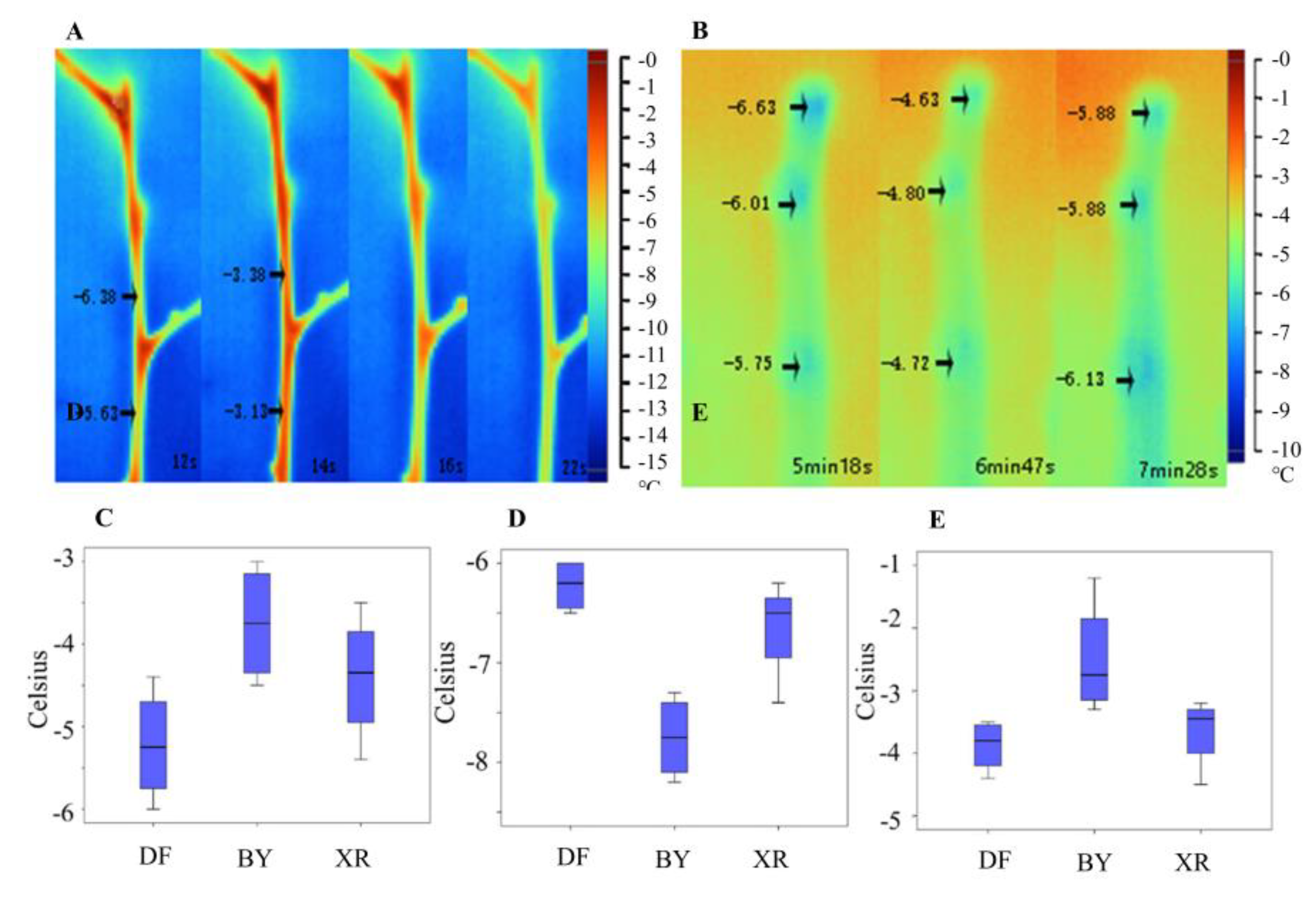
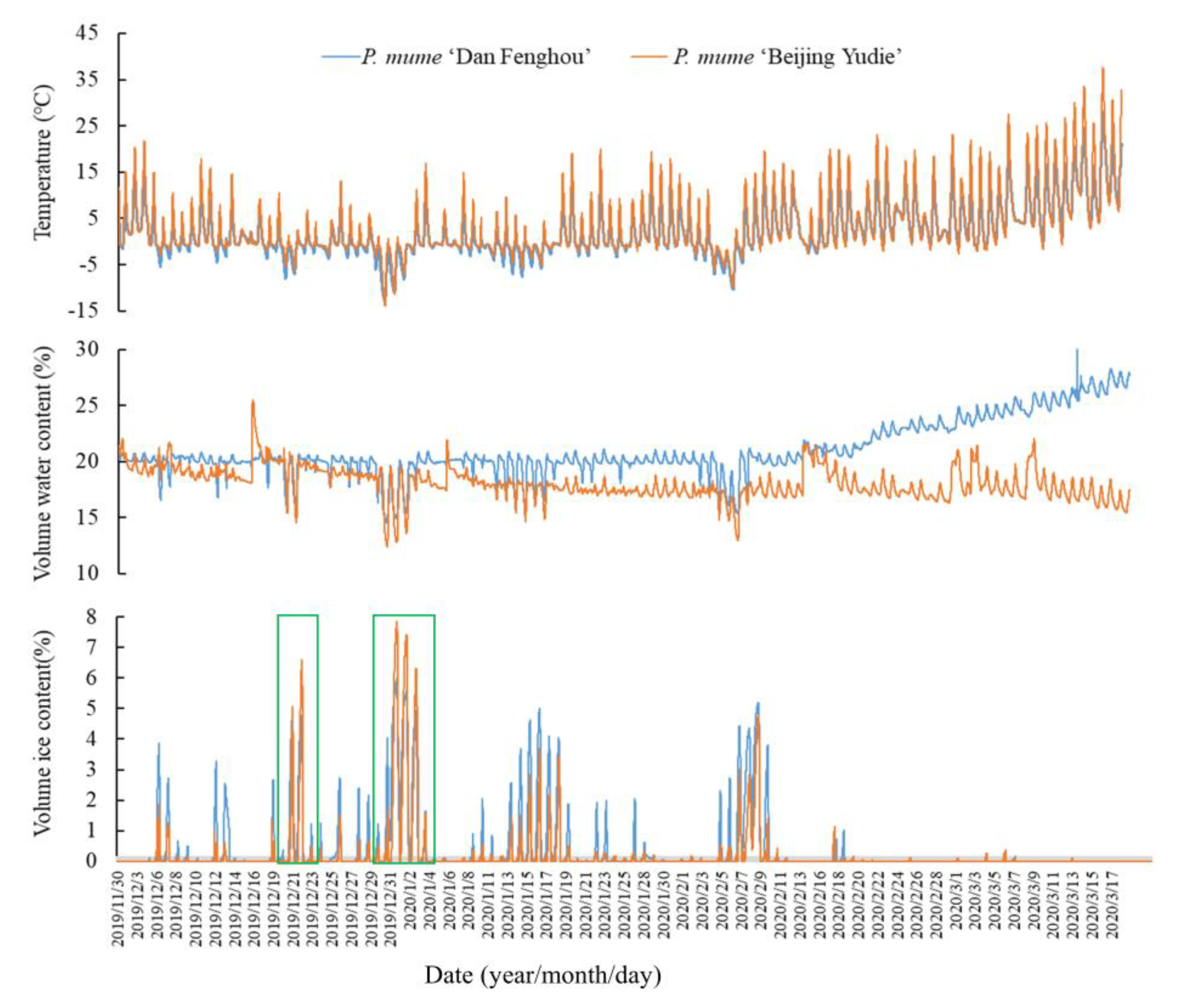
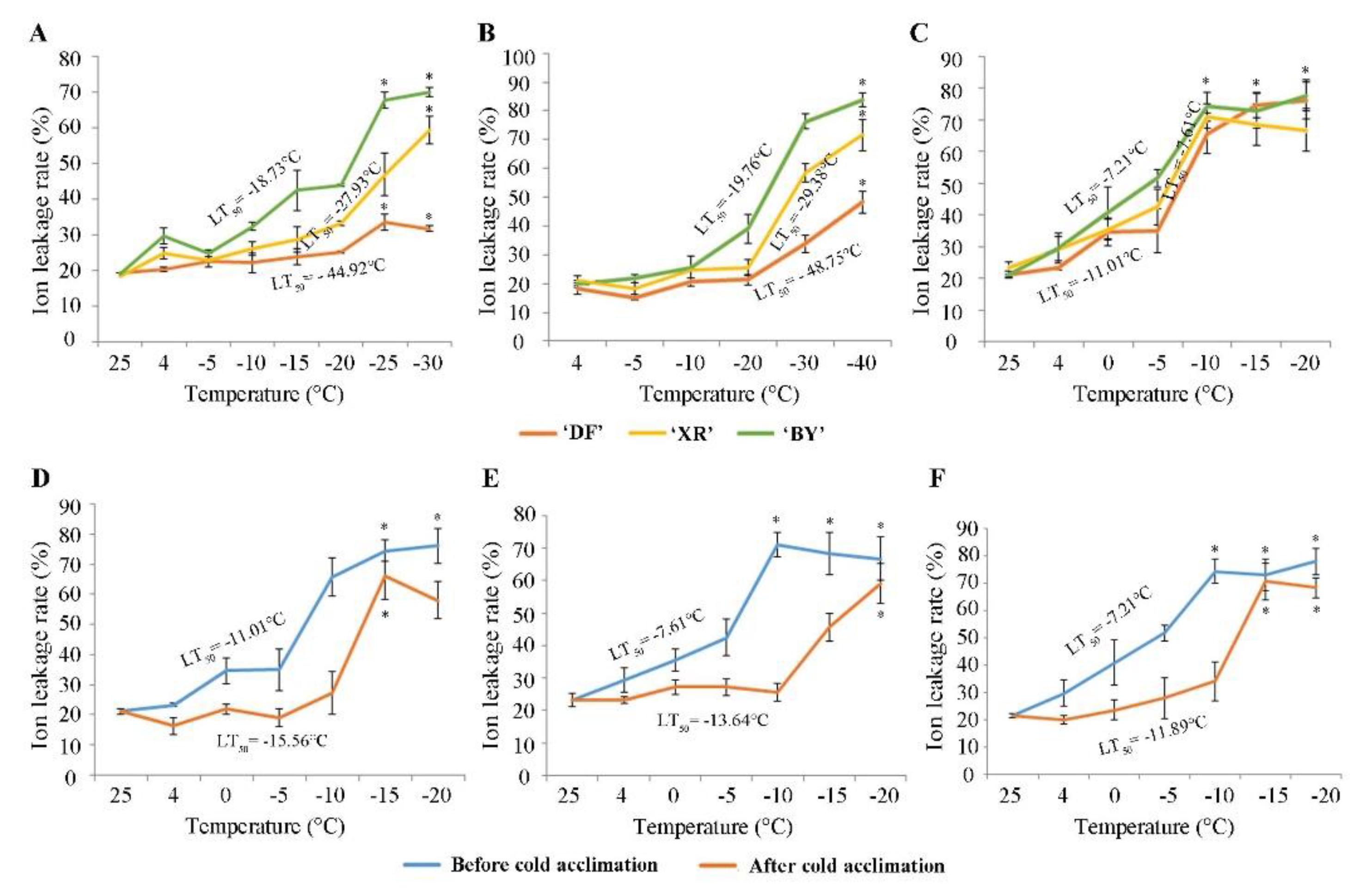
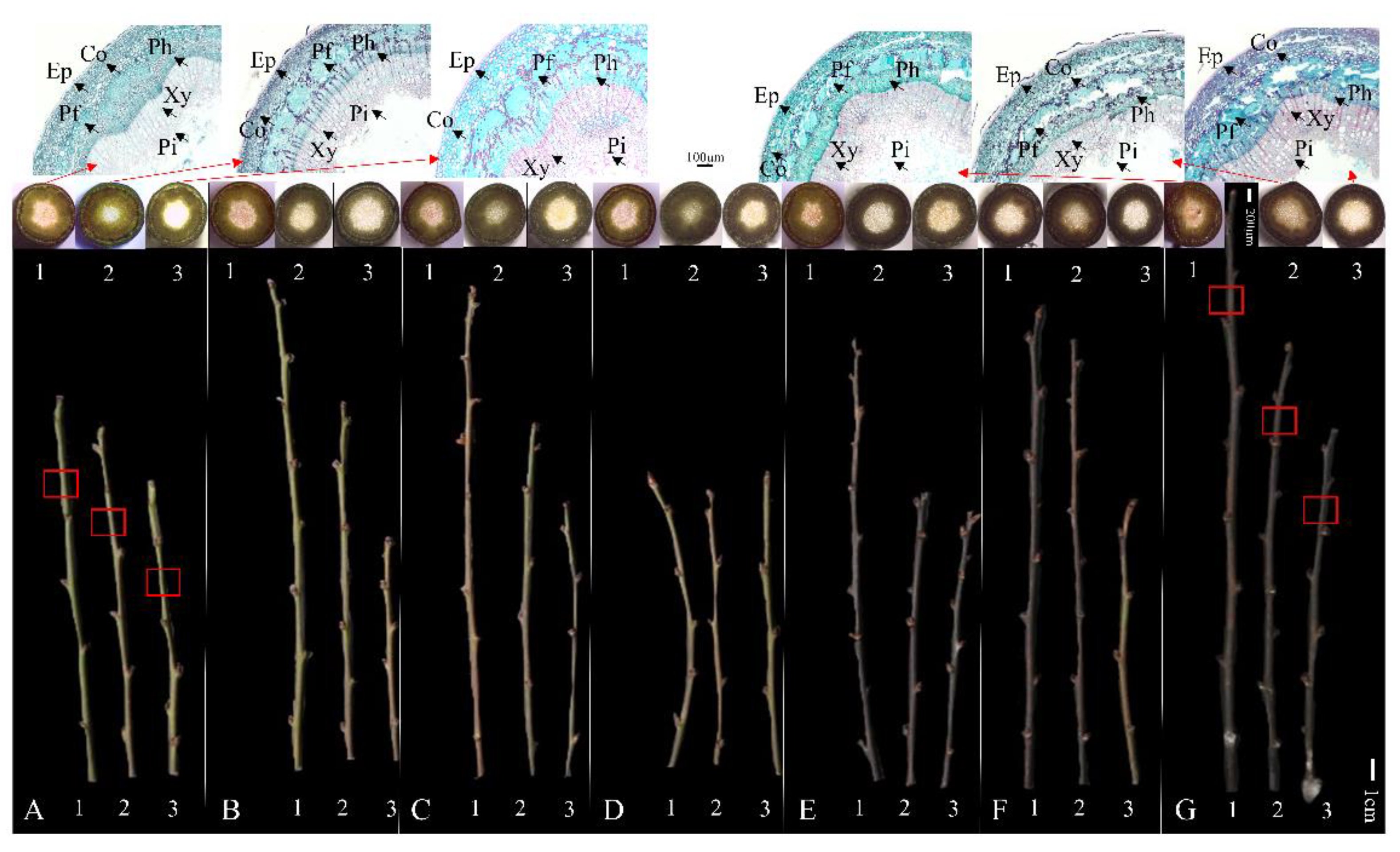
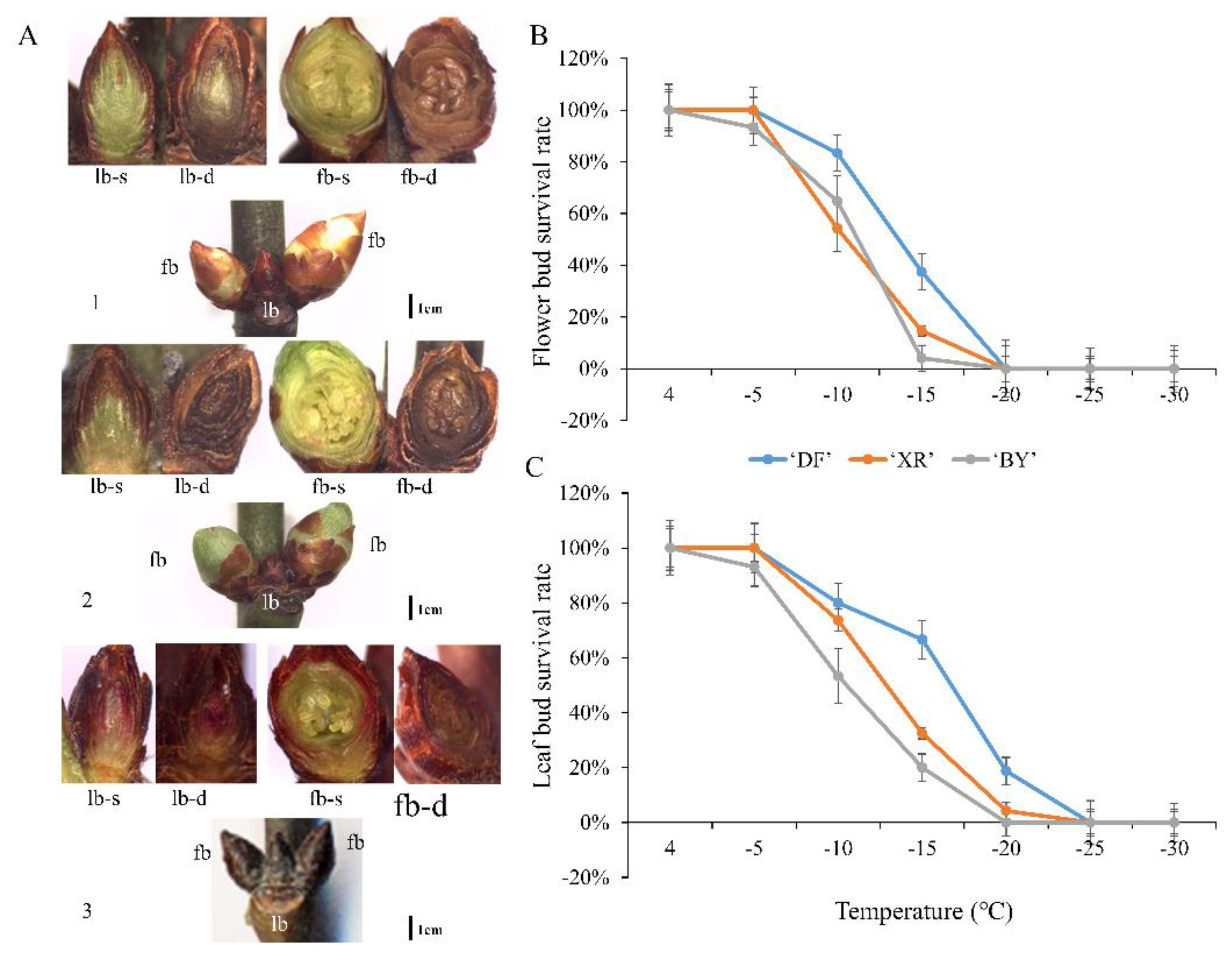

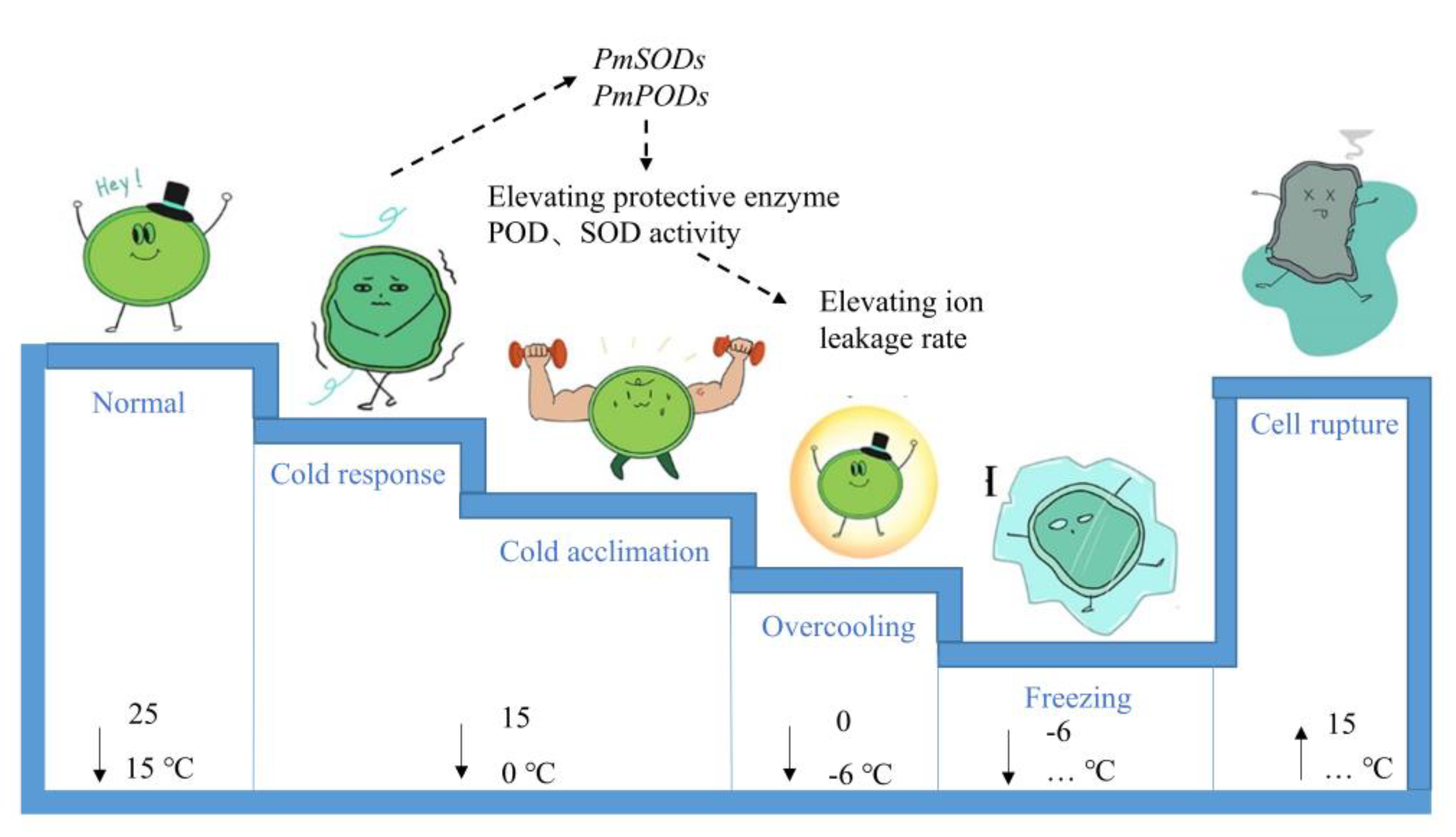
Publisher’s Note: MDPI stays neutral with regard to jurisdictional claims in published maps and institutional affiliations. |
© 2022 by the authors. Licensee MDPI, Basel, Switzerland. This article is an open access article distributed under the terms and conditions of the Creative Commons Attribution (CC BY) license (https://creativecommons.org/licenses/by/4.0/).
Share and Cite
Ding, A.; Bao, F.; Ding, A.; Zhang, Q. Cold Hardiness of Prunus mume ‘Xiang Ruibai’ and Its Parents Based on Biological Indexes and Physical Parameters. Forests 2022, 13, 2163. https://doi.org/10.3390/f13122163
Ding A, Bao F, Ding A, Zhang Q. Cold Hardiness of Prunus mume ‘Xiang Ruibai’ and Its Parents Based on Biological Indexes and Physical Parameters. Forests. 2022; 13(12):2163. https://doi.org/10.3390/f13122163
Chicago/Turabian StyleDing, Anqi, Fei Bao, Aiqin Ding, and Qixiang Zhang. 2022. "Cold Hardiness of Prunus mume ‘Xiang Ruibai’ and Its Parents Based on Biological Indexes and Physical Parameters" Forests 13, no. 12: 2163. https://doi.org/10.3390/f13122163




